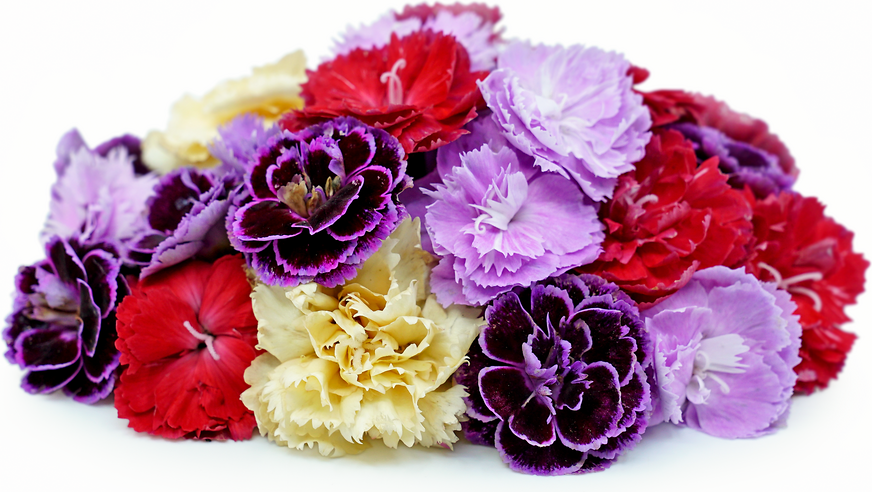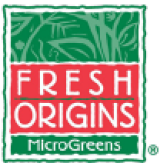


Carnations
Estimated Inventory, 50 ct : 20.00
This item was last sold on : 07/19/25
| Fresh Origins | Homepage |
Description/Taste
Carnations are small to medium flowers, averaging 3 to 6 centimeters in diameter, and have a round, layered, and slightly ruffled appearance. The blooms are comprised of broad, flat, and oblong petals with serrated, frilled edges. Carnations can be found in an assortment of colors, from crimson, white, pink, lavender, to purple picotee with brilliant violet edges, and the petals have a soft, velvety, and delicate texture. Depending on the variety, the flowers may also emit a faint, clove-like aroma or bear no fragrance. Carnations have a tender, subtly crisp consistency with a mild, sweet, and peppery flavor.
Seasons/Availability
Carnations are available year-round.
Current Facts
Carnations, botanically classified as Dianthus caryophyllus, are familiar flowers with ancient origins, belonging to the Caryophyllaceae family. The ruffled blooms are considered one of the most commonly cultivated flowers, valued for their hardiness and year-round availability, and have been used for centuries for ornamental purposes. In the modern-day, there are over 300 different cultivars of Carnations that have been developed to showcase brilliant colors, textures, and shapes, and some varieties have also been organically grown for culinary use. Chefs use Carnations to add texture, color, and subtle flavors to dishes, and the blooms are often viewed as a symbol of artistic timelessness, tradition, and elegance. Carnations can be incorporated whole as an elevated garnish, or the petals can be removed and sprinkled as an edible accent over sweet and savory preparations.
Nutritional Value
Carnations have been traditionally used by European herbalists in tea to calm anxiety, stress, and nausea. The petals are also believed to contain anti-inflammatory properties to balance hormones and reduce inflammation. In Traditional Chinese Medicine, Carnations have been infused into treatments to cleanse the digestive tract from parasites and are processed into an essential oil as a topical treatment for rashes, acne, and other skin irritations.
Applications
Carnations have a mild, peppery flavor well suited for a wide variety of fresh and cooked preparations. The petals are the primary part of the flower eaten, as the stamen, pollen, and sepal often impart a bitter taste. Once the petals are separated, washed, and dried, they can be sprinkled raw over salads, soups, rice, and pasta dishes, or they can be used as an edible garnish over any dish. Carnation petals can also be candied or crystallized, coated in egg whites and sugar to create a sweet and crisp decoration. The candied petals can be used to elevate cakes, cupcakes, cheesecakes, crème brulee, and pies. In addition to candying, the petals can be infused into a simple syrup and added to cocktails, lemonade, sparkling beverages, and desserts such as a sundae. Carnations can also be lightly cooked into savory dishes to showcase the flower’s peppery flavor. The petals are often mixed into sauces and butter, poured over roasted meats, eggs, and vegetables, or they can be lightly sauteed and mixed into grain bowls. Carnations can also be pickled with spices and vinegar to create a tangy mixture. Carnations pair well with cucumber, spinach, citrus, spices such as cinnamon, coriander, mint, and cloves, brown sugar, roasted meats, including poultry, turkey, and fish, and hard and creamy cheeses. The flowers should be used immediately for the best quality and flavor but will keep 5 to 7 days when stored in the refrigerator.
Ethnic/Cultural Info
Carnations are the official flower of Mother’s Day in the United States. Mother’s Day was established in 1914 by President Woodrow Wilson and was spearheaded by Anna Jarvis, an editor in Philadelphia. Jarvis created the holiday in honor of her mother, who had passed away, and wanted to commemorate all mothers, both living and deceased. In 1908, 3 years after her mother’s death, Jarvis brought 500 white Carnations to her mother’s home church and gave a flower to each mother in the service. Carnations, according to Jarvis, were her mother’s favorite flower. The church annually continued the Carnation tradition and eventually labeled it as their Mother’s Day service. Over the years, word spread, and many other churches began practicing the same tradition, encouraging Jarvis to lobby for the holiday to become a nationwide event. Mother’s Day was officially recognized in 1914, and Carnations became the official flower in the mid-1940s. Even though Jarvis originally handed out white Carnations as a symbol of purity, white Carnations became associated with lost mothers and were placed at gravesites. Red Carnations were instead selected for living mothers, and the vibrant, crimson blooms were meant to symbolize love, life, and passion.
Geography/History
Carnations are one of the oldest cultivated flowers and are believed to be native to the Mediterranean region. The blooms have been cultivated since ancient times, and pale orange and pink Carnations were said to have been utilized by the Ancient Greeks and Romans. Over time, Carnations were spread around the world with migrating peoples and have become established as a favored commercially cultivated flower. Today Carnations are widely found through supermarkets, farmer’s markets, specialty grocers worldwide. Carnations are also frequently grown in home gardens as a multi-purpose cultivar. It is important to note that edible Carnations are produced under strict standards and are grown differently from common Carnations sold as ornamental flowers. Care and research should be taken to ensure Carnations used for culinary purposes are purchased through reputable vendors.
Featured Restaurants
Restaurants currently purchasing this product as an ingredient for their menu.
| 619 Spirits | San Diego CA | 509-701-9534 |
| Lovesong | San Diego CA | 602-502-3460 |
| Rose Café | Carlsbad CA | 310-399-0711 |
| Venissimo Cheese Hillcrest | San Diego CA | 619-491-0708 |
| Birdseye Rooftop | San Diego CA | 619-206-7220 |
| The Plot Restaurant (Costa Mesa) | Costa Mesa CA | 714-852-3181 |
| The Santaluz Club Inc - Banquet | San Diego CA | 858-759-3150 |
| The Bower | Coronado CA | 949-212-3192 |
| insideOUT (Bar) | San Diego CA | 619-793-9221 |
| Q&A Oyster Bar & Restaurant | Oceanside CA | 858-245-3780 |
| Rancho Bernardo Inn (Avant) | San Diego CA | 858-675-8505 |
| Side Bar | San Diego CA | 619-348-6138 |
| GelatoLove | Carlsbad CA | 760-297-0554 |
| Moxy San Diego Gaslamp | San Diego CA | 619-376-1850 |
| Sushi Gaga | San Diego CA | 619-808-1556 |
| Revolution Roasters (Carlsbad) | Carlsbad CA | 760-330-6827 |
| Casero Taqueria | Carlsbad CA | 760-533-4997 |
| Good News Bar | San Diego CA | 541-233-7604 |
| Venissimo Cheese North Park | San Diego CA | 619-376-1834 |
| Dave Martin | San Diego CA | 949-378-2006 |
| Estancia Adobe | San Diego CA | 858-550-1000 |
| Boujiemana | San Diego CA | 415-710-0510 |
| Harvest Kitchen | Vista CA | 619-709-0938 |
| Sushi Nekosan | La Jolla CA | 858-999-0999 |
| Under Belly-Uptown (Bar) | San Diego CA | 619-269-4626 |
| Sugar Bear Enterprises | San Diego CA | 925-383-3623 |
| Pacific Yacht Agents | Los Angeles CA | 808-214-0970 |
| The Guild Hotel | San Diego CA | 619-764-5108 |
| Hotel Republic San Diego | San Diego CA | 951-756-9357 |
| Venissimo Cheese Del Mar | Del Mar CA | 858-847-9616 |
| Town & Country Bakery | San Diego CA | |
| Gelato 101 (Solana) | Solana Beach CA | 858-404-0799 |
| Rustic Root Solana (Bar) | Solana Beach CA | 619-955-5750 |
| Rustic Root (Bar) | San Diego CA | 619-702-5595 |
| La Costa Resort & Spa Pastry | Carlsbad CA | 760-431-8455 |
| Pendry SD (Provisional Bar) | San Diego CA | 619-738-7000 |
| La Costa Resort & Spa Main Kitchen | Carlsbad CA | 760-930-7063 |
| Camino Riviera Bar | San Diego CA | 619-685-3881 |
| Kettner Exchange Bar | San Diego CA | 909-915-9877 |
| Upper East | Escondido CA | 619-787-1617 |
| Cloak and Petal | San Diego CA | 626-319-6878 |
| Saint Mark Golf and Resort, LLC (Bar) | San Marcos CA | 508-320-6644 |
| Maya Moon Collective | San Diego CA | 775-225-8649 |
| Starlite Bar | San Diego CA | 619-358-9766 |
| Choi's | San Diego CA | 858-900-1224 |
| Selva Coffee | San Diego CA | 619-585-1118 |
| Manchester Grand Hyatt San Diego | San Diego CA | 619-232-1234 |
| The Whaling Bar (Bar) | La Jolla CA | 858-355-9218 |
| Cloak and Petal Bar | San Diego CA | 619-501-5505 |
| Marriott Courtyard - Broadway | San Diego CA | 619-446-3008 |
| The Seabird Resort | Oceanside CA | 442-222-9505 |
| Waverly (Bar) | Cardiff CA | 619-244-0416 |
| Fairmont Grand Del Mar | San Diego CA | 858-314-1975 |
| The Flavor Chef (Catering) | Vista CA | 619-295-3172 |
| Revolution Roasters | Oceanside CA | 760-330-6827 |
| Jalisco Cantina | Carlsbad CA | 619-204-5945 |
| Farmer and The Seahorse | San Diego CA | 619-302-3682 |
| Fresh Sushi Catering | Carlsbad CA | 858-344-7098 |
| Taproom Collective | San Diego CA | 760-518-4242 |




 Learn More...
Learn More...
